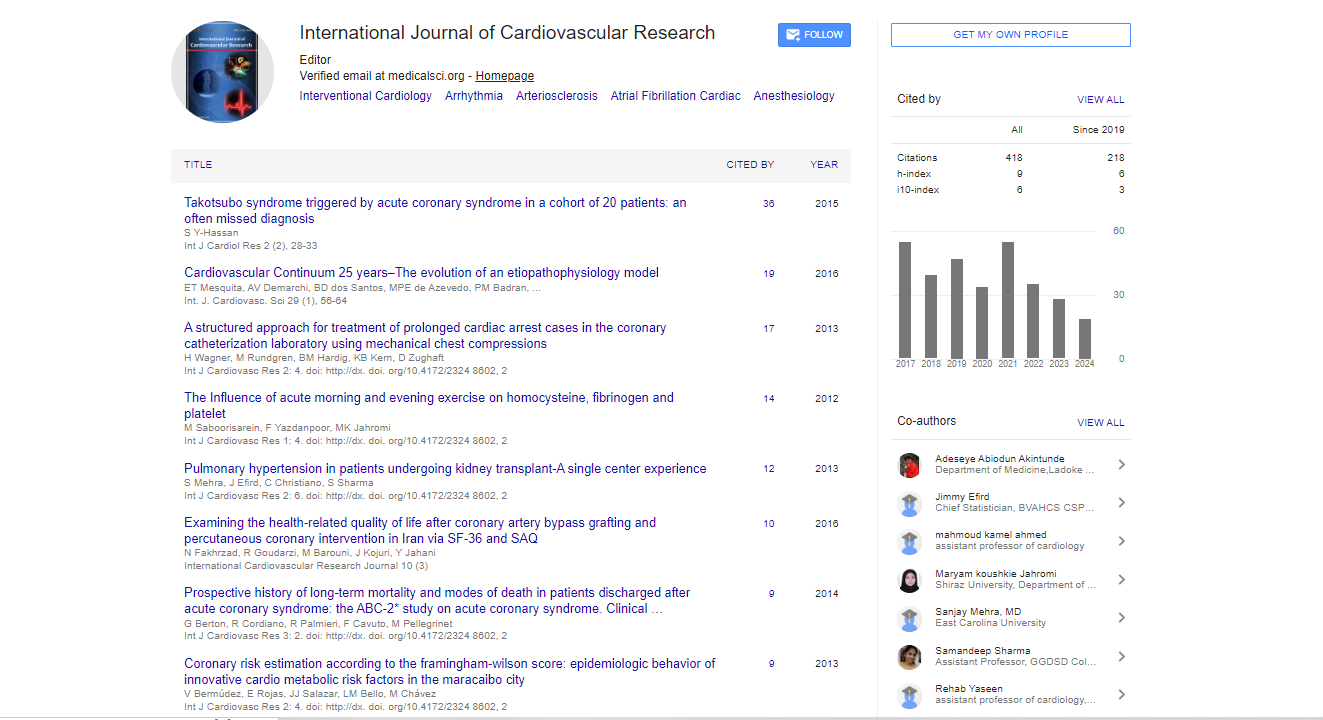Perspective, Int J Cardiol Res Vol: 13 Issue: 6
MicroRNAs and Epigenetic Modifications in the Pathogenesis of Heart Disease
Wei Zhang*
1Department of Cardiology, Peking University First Hospital, Beijing, China
*Corresponding Author: Wei Zhang,
Department of Cardiology, Peking University, First Hospital, Beijing, China
E-mail: wei.zhang@pku.edu.cn
Received date: 28 November, 2024 Manuscript No. ICRJ-24-156845;
Editor assigned date: 02 December, 2024, PreQC No. ICRJ-24-156845 (PQ);
Reviewed date: 16 December, 2024, QC No. ICRJ-24-156845;
Revised date: 23 December, 2024, Manuscript No. ICRJ-24-156845 (R);
Published date: 30 December, 2024, DOI: 10.4172/2324-8602.1000594.
Citation: Zhang W (2024) MicroRNAs and Epigenetic Modifications in the Pathogenesis of Heart Disease. Int J Cardiol Res 13:6.
Description
Heart disease remains a leading cause of morbidity and mortality worldwide, presenting a significant challenge to healthcare systems. While traditional risk factors such as hypertension, hyperlipidemia and smoking have long been implicated in its pathogenesis, emerging evidence emphasizes the critical role of epigenetic regulation and Micro ribonucleic acids (microRNAs) in the development and progression of cardiac disorders. MicroRNAs are small, non-coding RNAs approximately 22 nucleotides long, that regulate gene expression post-transcriptionally. By binding to the 3' Untranslated Region (UTR) of target mRNAs, they either inhibit translation or promote mRNA degradation. In the heart, miRNAs are indispensable for maintaining cellular homeostasis, controlling processes such as cardiomyocyte proliferation, apoptosis, fibrosis and vascular remodeling. Circulating miRNAs hold immense assurance as noninvasive biomarkers for heart disease. For example, elevated levels of miR-208 and miR-499 in plasma are indicative of myocardial injury. Their stability in bodily fluids and specificity to cardiac tissues make them attractive diagnostic tools. Moreover, their profiles often reflect disease severity and therapeutic response, facilitating dynamic monitoring. Epigenetics refers to heritable changes in gene expression that do not involve alterations in the DNA sequence. These modifications include Deoxyribonucleic acid (DNA) methylation, histone modifications and chromatin remodeling, all of which are pivotal in heart development and disease.
In heart disease, aberrant methylation patterns contribute to pathological remodelling. Hypermethylation of sarcomeric protein genes can impair contractile function. Hypomethylation of inflammatory cytokine genes accelerates plaque formation. Histones are proteins around which DNA is wound and their post-translational modifications influence chromatin accessibility. In heart failure, global hypoacetylation of histones has been observed, correlating with reduced expression of cardioprotective genes. Histone Deacetylases (HDACs) are particularly implicated in maladaptive cardiac hypertrophy. Chromatin remodeling complexes, such as the SWItch/ Sucrose Non-Fermentable (SWI/SNF) family, play an important role in cardiac gene expression. Dysregulation of these complexes has been linked to congenital heart defects and arrhythmias. The relation between chromatin architecture and environmental stimuli underscores the dynamic nature of epigenetic regulation. The relationship between miRNAs and epigenetics is bidirectional and intricate. MiRNAs can influence epigenetic machinery by targeting enzymes such as DNA methyltransferases (DNMTs) and HDACs, thereby modulating DNA methylation and histone acetylation. However, epigenetic changes can regulate miRNA expression, creating feedback loops that fine-tune cardiac responses. Small molecules targeting epigenetic enzymes, such as DNMT inhibitors and HDAC inhibitors are being evaluated for their cardio protective effects. These agents have shown efficacy in reducing pathological hypertrophy and fibrosis, although their systemic effects warrant caution. Given the interaction between miRNAs and epigenetics, combination therapies targeting both pathways may offer synergistic benefits. For instance, simultaneous modulation of miR-29 and histone acetylation pathways could enhance anti-fibrotic effects. Future study should focus on integrating multi-omics approaches to unravel the interplay between genetic, epigenetic and environmental factors in heart disease. Advances in CRISPR-based technologies and single-cell sequencing hold promise for precision medicine, enabling tailored interventions based on an individual’s molecular profile.
Conclusion
MicroRNAs and epigenetics represent a border in our understanding of heart disease. Their roles as regulators of gene expression and mediators of environmental responses emphasize their significance in cardiac health and pathology. While challenges persist, the clarity gained from studying these mechanisms lead to transformative approaches to diagnosis, treatment and prevention.
 Spanish
Spanish  Chinese
Chinese  Russian
Russian  German
German  French
French  Japanese
Japanese  Portuguese
Portuguese  Hindi
Hindi 



